And now it is finally official – Quique Setien, the former Real Betis and Las Palmas manager, has taken over the reins at Barcelona and has replaced Ernesto Valverde, beating the likes of Mauricio Pochettino to the job in the process. Two and a half years after his appointment, the Basque coach is leaving Catalonia and the 61-year-old will take his place.
This tactical analysis will give you an in-depth insight into Setién’s tactics and his general philosophy and will try and use analysis to determine how his systems can be incorporated into Barcelona’s style of play.
General tactics
When talking about Barcelona and their heritage, tradition and overall style, we usually talk about the so-called Juego de Posición or positional play. This footballing principle has a vast array of different tactics but is mainly preoccupied with maintaining superiorities across the pitch – either through movement, manipulation, occupation of advantageous zones and areas or simply through superior positioning and understanding of time and space on the pitch.
Barcelona, especially under the guidance of Pep Guardiola, were the very definition of positional play and its tactics. Over the years, the Cruyffian influence started veining and seemingly reached its climax with Valverde’s conservative approach.
Setién’s tactics and his system, however, could be described as the very opposite of conservative – fast, aggressive, attractive and most importantly – based on the very principles Johan Cruyff and Pep Guardiola were preaching all those years ago.
The new Barcelona coach bases his whole philosophy on the teachings of the two Blaugrana icons and sees a game of football as a game of chess – something that is as intriguing as it is symbolic.
Subsequently, quick rotations, creation and exploitation of space, superiorities across the pitch and manipulation of the opposition’s movement are crucial to his tactics and will all be looked at in this tactical analysis.
We will split this piece into different sections looking at Setién’s tactics on and off the ball and see how all of that could be transcribed to the current Barcelona team.
Superiorities and playing out of the back
Setién’s tactics on the ball are based on the domination of possession. The main idea behind his approach is to hold the ball and hide it from the opposition, which, interestingly enough, is the very principle Barcelona base their tactics on as well.
Real Betis were extremely good at this and their team could be characterised as brave in possession regardless of the opposition on the other side of the pitch and regardless of how their opponents decided to approach the game themselves.
With that being said, everything always starts with the goalkeeper and the defensive line. But intriguingly enough, Setién adores playing with a back three and a pivot in front of that first line, and just like with everything else when moving forward, creating superiorities is essential.
In the first phase of the build-up play, this is achieved with the three centre-backs and the holding midfielder who regularly drops deeper to assist the transition of the ball and helps combat the high press or blocking of the channels from the opposition.
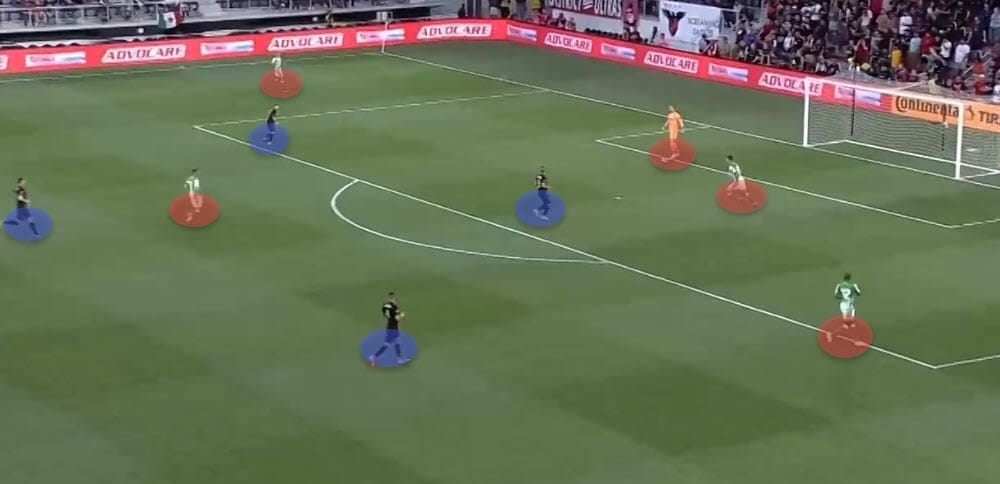
You can see an example of such an approach above as Real Betis find their way to a higher platform by combining with the pivot and escaping the press. When moving from and into the final third, the principles remain the same – achieve superiority in the wider areas and get the wing-backs into advantageous positions.
This is then achieved by dropping one of the higher-positioned players a bit deeper and the ball-near midfielder closer to the ball-carrier. As a result, Real Betis can pin the opposition inside either a triangle or a rhombus, both of which can be seen in the following examples.
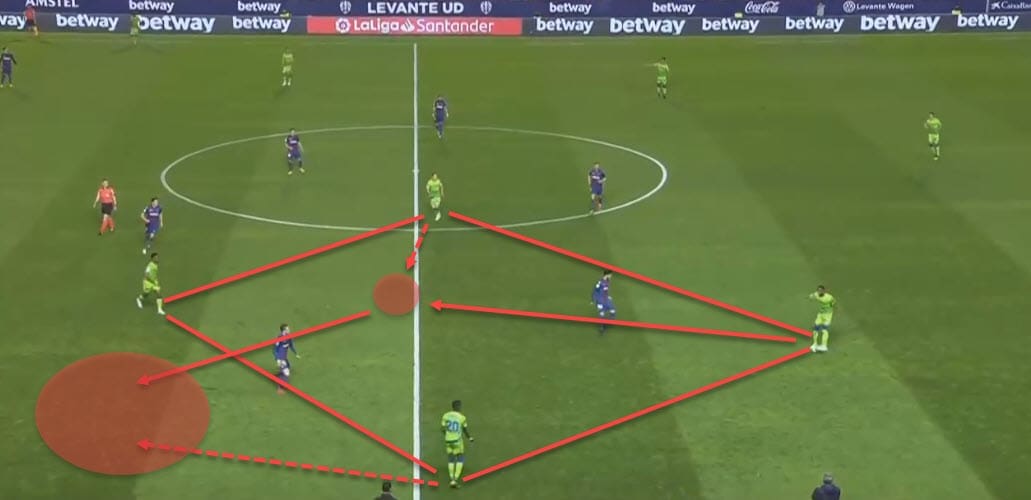
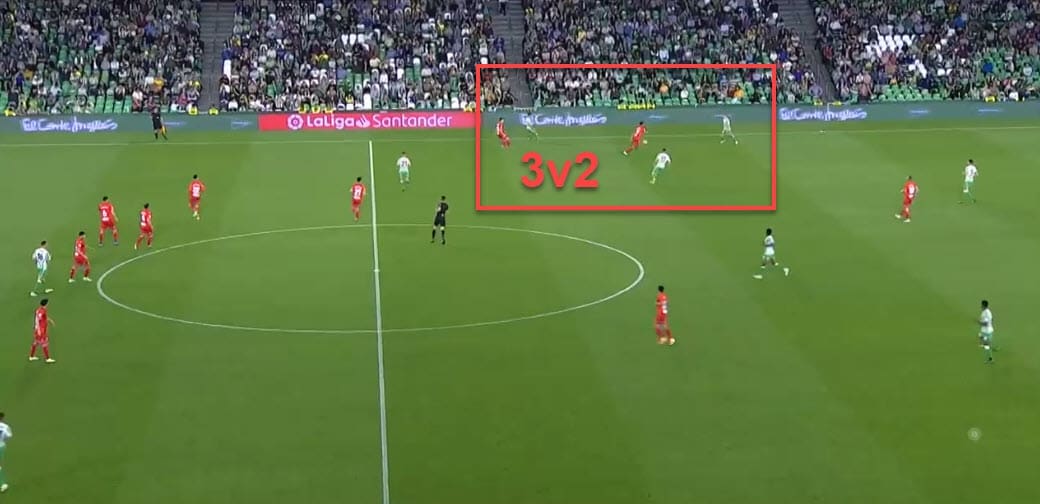
Notice how in both instances there are more Real Betis players than the opposition’s and by dropping additional personnel deeper down the pitch, Setién makes sure that his players always have an option to pass to.
This is the second aspect of his tactics that makes sure that control can be retained in tight spaces. Setién sees the “rondo” as a way of identifying the players that are capable of executing his philosophy and keep the ball in their possession at all times and in all situations.
For that reason, creating triangles and rhombuses across the pitch is essential as it makes sure that every player has a passing channel available to him at all times. This makes manoeuvring through tight spaces and opposition’s high press manageable if not even easy.
But Real Betis are also a team that likes to invite pressure and use it against the opposition at all times. For instance, notice in the following examples below how they first draw their counterparts in and then quickly switch the play to find a free man on the opposite side of the pitch.
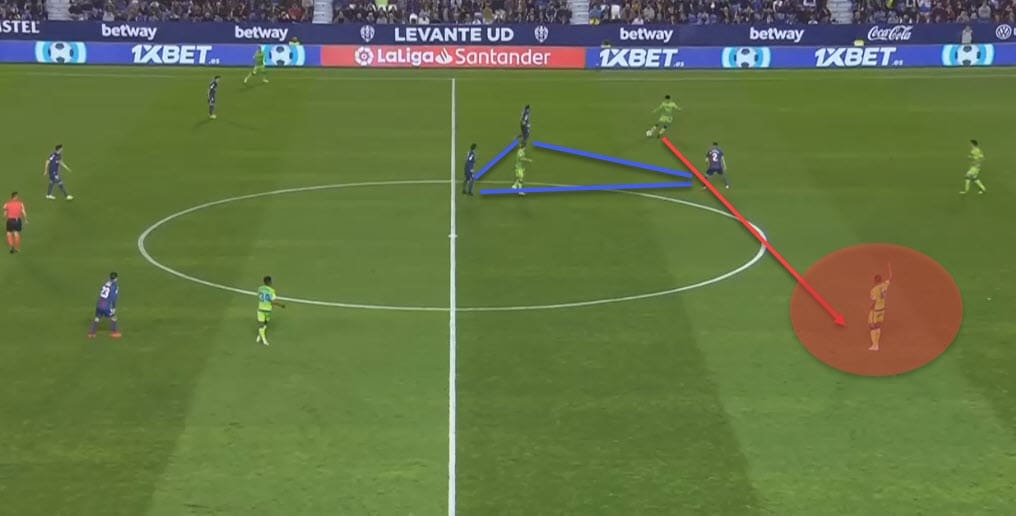
In this instance above, Levante put numbers up front and press with intensity and pace but they also leave a lot of space behind them in the process. And while this is far from a favourable situation, Setién’s systems also rely on ball-playing centre-backs and a sweeper-keeper who can play with his feet.
Here, one of his centre-backs switches play with ease and another can take the ball, surge forward with intent and then provide a vertical pass onto a higher platform towards the final third and a dropping forward who is arriving into his respective half-space.
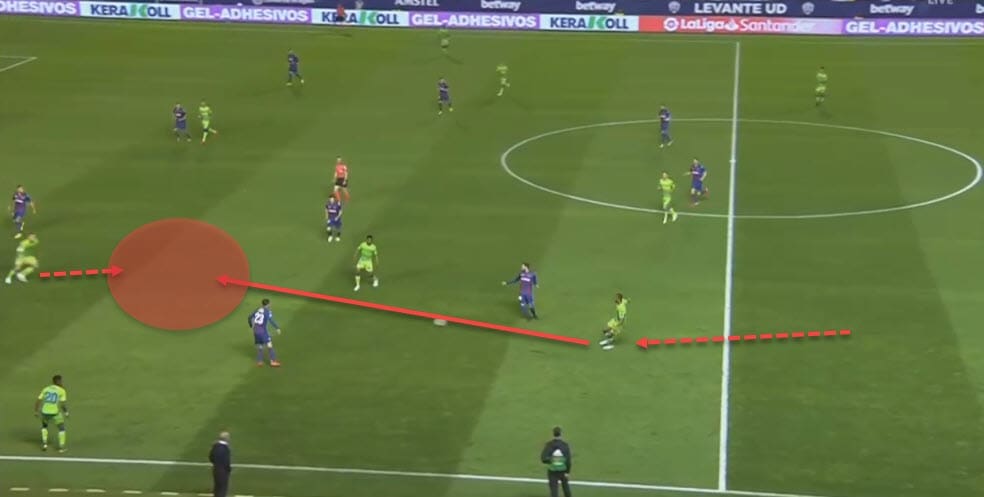
This is a common pattern used in Setién’s tactics and will be further analysed in this tactical analysis but it’s also something that we often see Barcelona implement in their routines. All of Gerard Piqué, Clement Lenglet, and Samuel Umtiti are excellent on the ball and very well capable of deploying vertical passes.
Generally speaking, a usual sequence of play coming from the back would look something like the example below shows – the ball is recycled across the backline but while at first, it may seem like they’re “passing for the sake of passing”, Real Betis are actually looking for an opening in the middle of the pitch to progress the ball.
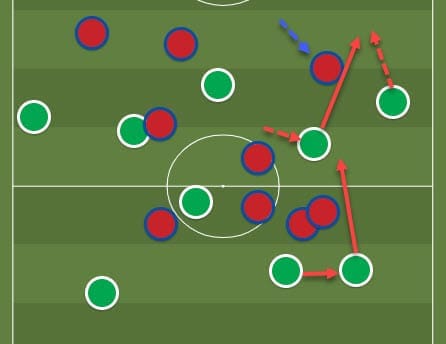
It is then quickly moved to the right side and the midfielder around the centre of the pitch is following the movement of the ball closely and subsequently shifts towards the wide area and into the right half-space.
Since the centre-backs are highly technical and brave on the ball, they will often opt for the vertical pass in this instance, finding their teammate who can then immediately send another pass behind the opposition’s backs and straight into the path of his sprinting wing-back.
A big part of the job will be breaking down compact low-blocks and teams who like to turtle up and wait out the storm. But Real Betis have already faced their fair share of such squads and Setién knows quite well how to pull them apart.
Usually, this will involve recycling possession and circling around the opposition until an opening can be found. In that moment, through vertical passes and swift rotations – which we will analyse further down the line of this tactical analysis – Real Betis dance around their counterparts and surge towards the box.
Often teams will deploy a rather narrow system so as to congest the middle of the pitch and prevent vertical passes through those channels being made. But Setién’s sides don’t have a problem with exploiting the wider areas. In fact, this is one of their strengths as well.
This is done either through swapping of sides, as we’ve already mentioned or through utilising their wing-backs effectively. Notice below how Real Betis use an extension of the 3rd man principle and do a slight variation of it.
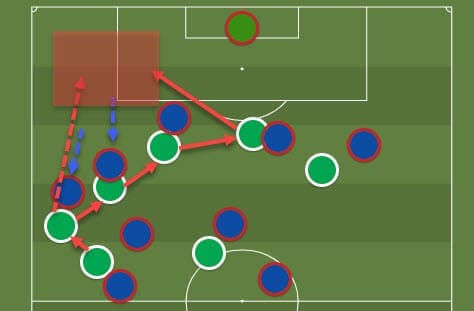
The goal is to get the ball to Junior Firpo, who is the player near the touchline on the left. He receives it but is heavily marked as the opposition – in this instance, poetically, Barcelona – close him down rather quickly. At this point in time, it’s difficult for him to surge forward because he doesn’t have the space to run into.
But as soon as his forward drops deeper to receive the pass, as can be seen above, he pulls the opposition defender out of his shape and creates space. The ball is then quickly progressed with one-touch passes to higher platforms while the wing-back makes a darting run into the newfound space.
This is just an example of how Setién utilises the wide areas combined with movement manipulation to create and exploit space.
This tactical analysis will now turn to the scenarios in which Setién is forced to face high pressure and structural closing of the passing channels as well as his own pressing tactics.
Pressing and escaping pressure
It’s impossible to talk about Setién’s tactics and not mention the extensive research and preparation that goes into his pressing mechanism and subsequently, in the ways to successfully avoid being pressed by the opposition.
One of Barcelona’s banes in the last couple of seasons was definitely in both of those aspects as the Blaugrana now seem like a shadow of their former selves when it comes to either pressing the opponent or being press-resistant themselves.
And while they do have an ageing squad and at least two players – Lionel Messi and Luis Suárez – who are not as active in the defensive phases (or completely inactive at times), it stands to reason, having seen his previous stints at both Las Palmas and Real Betis, that Setién will demand the return of the Guardiola’s famous counter-pressing rule.
In general, all of his teams are always brave in and out of possession and even though they do have systems in place to shut down the channels and prevent counter-attacks, Setién will more often than not opt for the aggressive approach of a high-press.
Once again, in a completely poetic manner, the best example of Real Betis’ press has arrived from the 3-4 triumph at the Camp Nou against Barcelona. It was clear from the start that the guests would press high up the pitch and basically man-mark every single Blaugrana player, as can be seen below.
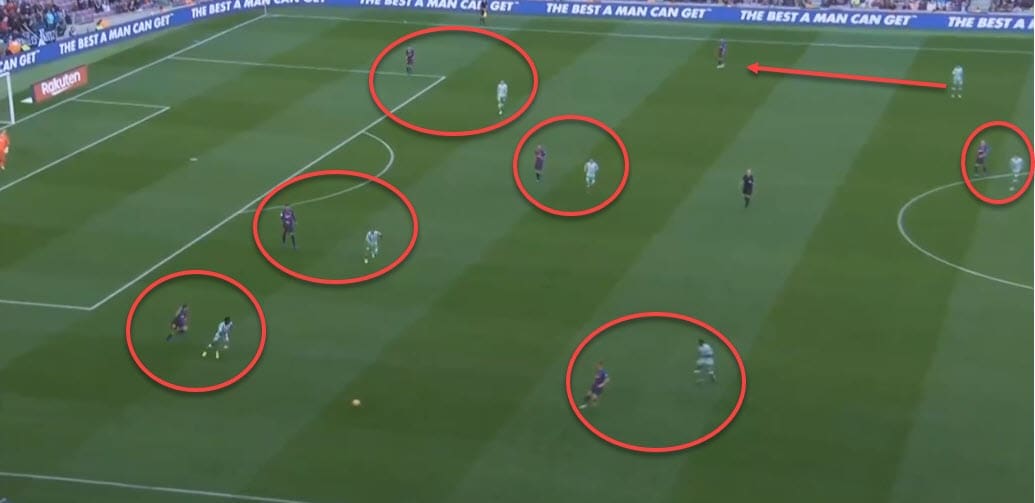
Note that Setién purposefully tweaked his system so as to mirror that of Valverde, practically setting up 1v1 duels all across the pitch and negating Barcelona all options of advancing the play forward.
Of course, with Marc-André ter Stegen in-between the sticks – a goalkeeper famous for his brilliant footwork and vision – it was pretty evident that Barcelona would try and escape the press by finding free pockets of space across the park.
But Setién was ready for that and he instructed his troops to be aggressive and pounce on every single ball and follow the ball-carrier until possession can be retrieved, preferably in advantageous positions and higher up the pitch. You can see such an example below as Marc Bartra leaves his centre-back position in an attempt to chase Messi off the ball.
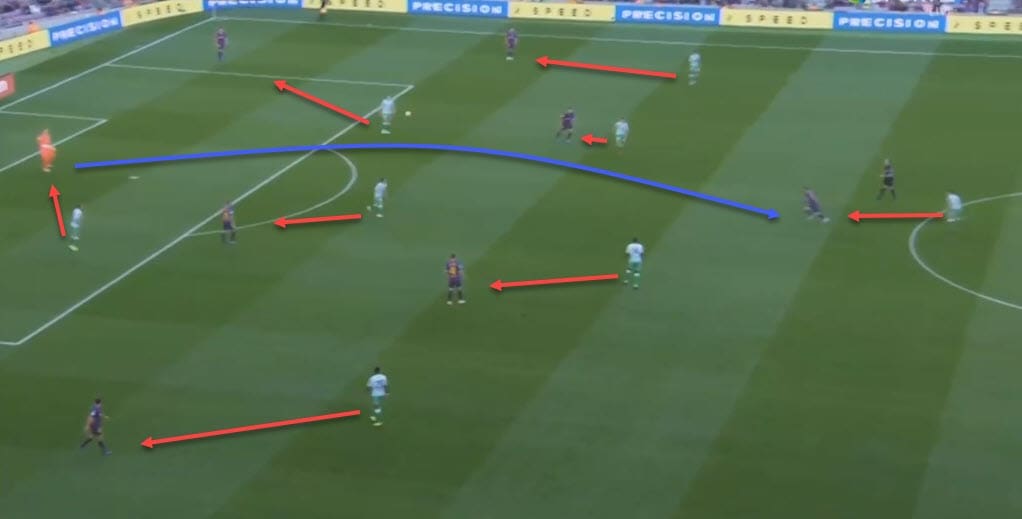
This is an effective but extremely demanding part of Setién’s tactics that he might have trouble implementing at Barcelona. The reason behind that is the personnel he has at his disposal.
We have already mentioned how both Messi and Suárez usually enjoy lesser defensive duties and that leaves Barcelona with nine or eight men to defend against a team of 10 on the other side (excluding the goalkeeper).
There are ways of mitigating the damage, of course, such as picking players like Arturo Vidal or Ivan Rakitić – workhorses with lots of stamina who can cover for the absence of their teammates – but ideally, Barcelona should either bench one of their superstars or at least one should be instructed to consistently track back.
Of course, Suárez is the candidate for both scenarios as Messi makes up for his defensive inactivity with moments of pure magic while the Uruguayan has been guilty of dragging the team down despite his goals and occasional heroics.
But we’ve already mentioned that despite having the likes of Sergio Busquets and Frenkie de Jong in the team, the Catalans have largely struggled under pressure. So how does Setién usually escape the high-press his teams face?
Generally speaking, in these situations, he will once again aim to achieve numerical superiority over his opposition as the premise on which the first phase of his attack lies. Notice below a fairly standard scheme in which the midfielder drops into deeper areas in order to provide an additional passing channel to his centre-back.
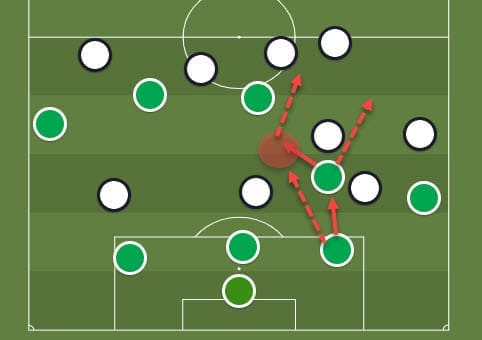
And as soon as he collects the ball, he will lay it off for that same centre-back who will surge forward and progress the play into higher areas of the pitch. For that reason, as was explained earlier in this tactical analysis, having technical defenders is extremely important for Setién’s tactics.
These techniques with the lay-offs are pretty common, as is the tendency of midfielders or winger to drop deeper (or stay high and wide, depending on the situation) in order to assist the build-up.
You can see such an example below where Real Betis outnumber Real Madrid and always have plenty of options to choose from in order to escape the press.
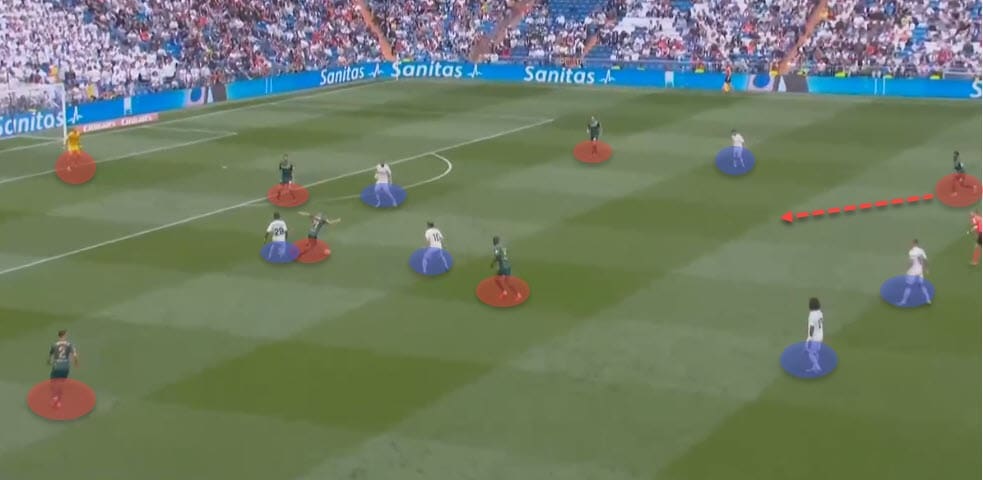
Of course, this brings us back to our initial thesis that stated there always have to be open channels for every player and in every situation and they have to be able to execute these passes and control the ball in tight areas.
But Setién also insists on the goalkeeper to be heavily involved in all the proceedings on the pitch. Often, it will be his task to find pockets of space further up the park in order to use the opposition’s press against them.
We can see an example of that below as Real Betis use both the goalkeeper’s vision and the dropping of a higher-positioned player to escape the press once again.
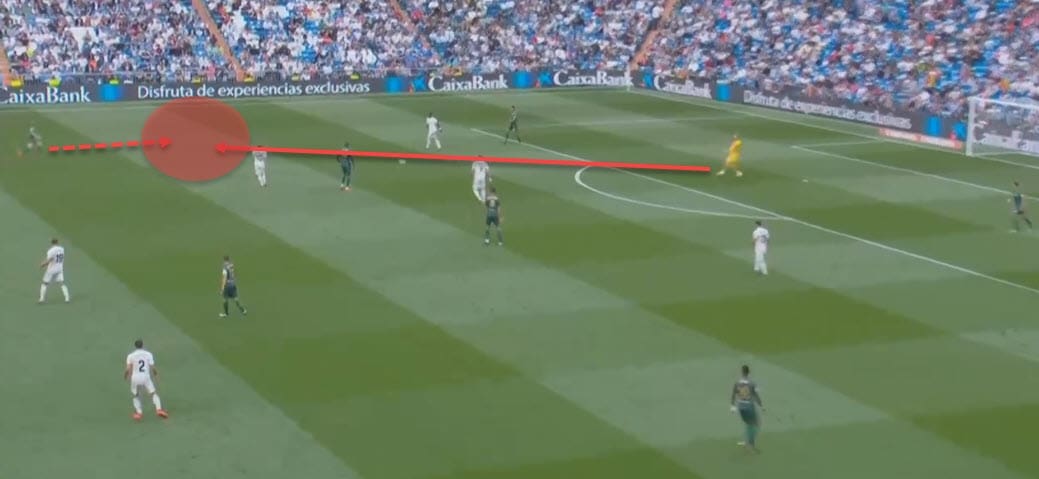
With Ter Stegen’s incredible technique and the tendency of Busquets to drop deeper, we could easily see these tactics implemented and perfected at Barcelona.
Are these tactics going to work at Barcelona?
And this is the million-dollar question but on paper, Setién and Barcelona truly are 100% compatible. The 61-year-old coach should seamlessly slot into the dugout and the team should already be used to the techniques and tactics that he’s bringing with him.
Even though he prefers the formation with three at the back, he’s been known to experiment with different kinds of systems and the formation on paper should not matter too much. The philosophy, however, will.
Barcelona already have a similar system in place and they tend to utilise most of the aspects we’ve mentioned in this tactical analysis. In the build-up play, the holding midfielder, in this case Busquets, will still drop deep, mostly even in-between the centre-backs, who will subsequently drift apart, allowing the full-backs to show their full attacking repertoire.
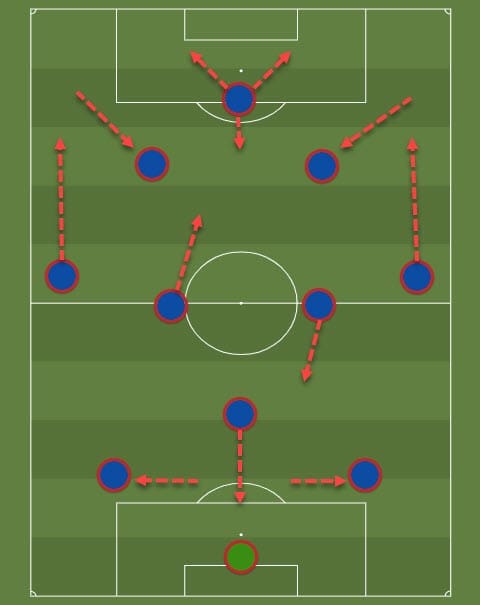
When going forward, the no.10 and no.8 will get the creative freedom to roam the final third and position themselves in and around the zone 14, drifting around their respective half-spaces. The winger on the left will also be tucked inside so that the full-backs have enough freedom to surge forward and use the full width of the pitch.
Seeing how most teams turtle up against Barcelona, utilising the wide areas will be key for Setién and the distribution from the wings has to be on point.
After reaching the opposition’s half, the key will be to create as many triangles and passing lanes as possible, which can be seen in the graphic below. Barcelona will recycle possession and circulate the ball until an opening can be found, using movement manipulation and rotations to get their opposition out of their defensive shape.
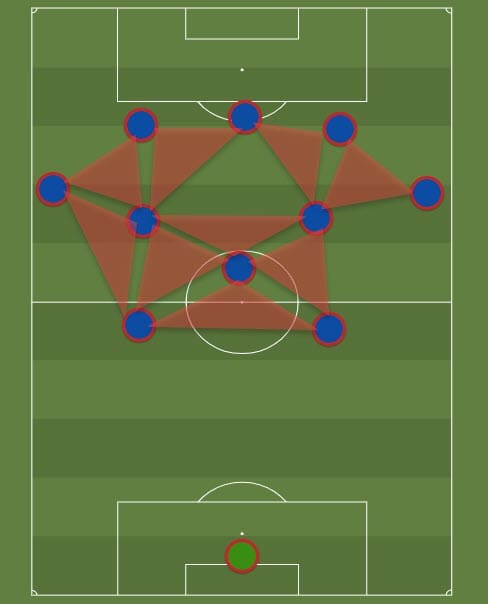
Finally, the biggest task for Setién at Barcelona will be sorting their off the ball tactics. He loves to press high, aggressively and ruthlessly but the Catalans don’t have the legs for such a task and it will be interesting to see how he adapts.
Trying to recover the ball higher up the pitch will likely be his initial idea but it remains to be seen whether it can be executed properly. When not pressing, however, Barcelona usually drop into a 4-4-2 formation with Messi and Suárez devoid of any real defensive tasks.
This will have to be sorted immediately or compensated with changes in other areas of the pitch. We’ve seen Setién pull all of his troopers behind the ball before but the gist remained the same – work hard and contribute, be aggressive and always look for the opportunity to snatch the ball away.
A new are dawns in Catalonia and we’re all eager to see Setién in action come the weekend.
Final remarks
Many Barcelona fans were dreaming of the return of Juego de Posición and with Setién’s arrival to Catalonia, positional play just might come back to the Camp Nou. If his past ventures are anything to go by, the 61-year-old manager is a coach who not only worships the purist positional way of playing and tactics that surround it but is also a man who constantly improves and promotes his players.
On paper, Setién and Barcelona are a match made in heaven and he could very well be the one to bring the joy back into their hearts and fire back into their play.
But we should also be wary of such sweeping declarations since Setién, for all his qualities, has never coached a top team and Barcelona will be his first big project after years of flirting with top spots in La Liga with Real Betis and fighting for supremacy of the middle of the table with Las Palmas.
The future looks bright but only time will how successful will the new gaffer be.






Comments